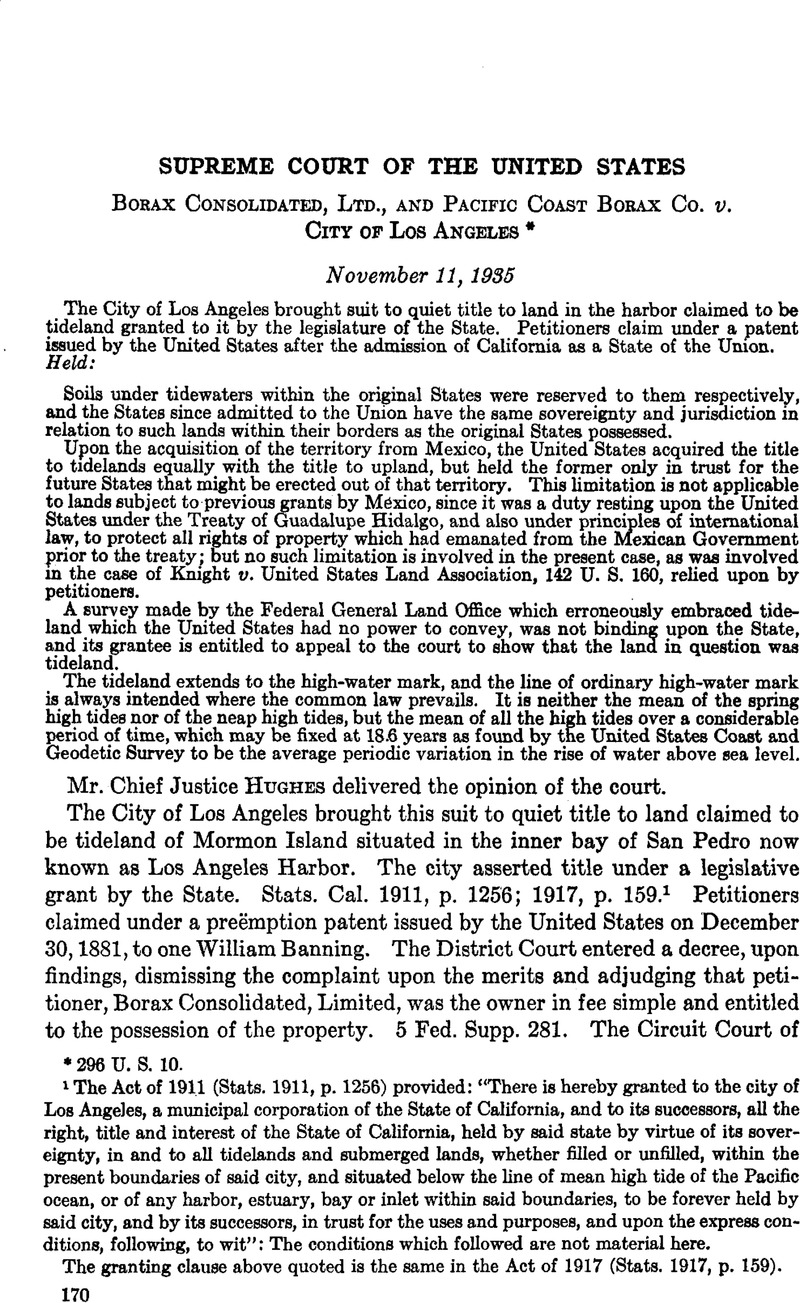No CrossRef data available.
Published online by Cambridge University Press: 12 April 2017

296 U. S. 10.
1 The Act of 191.1 (Stats. 1911, p. 1256) provided: “There is hereby granted to the city of Los Angeles, a municipal corporation of the State of California, and to its successors, all the right, title and interest of the State of California, held by said state by virtue of its sovereignty, in and to all tidelands and submerged lands, whether filled or unfilled, within the present boundaries of said city, and situated below the line of mean high tide of the Pacific ocean, or of any harbor, estuary, bay or inlet within said boundaries, to be forever held by said city, and by its successors, in trust for the uses and purposes, and upon the express conditions, following, to wit”: The conditions which followed are not material here.
The granting clause above quoted is the same in the Act of 1917 (Stats. 1917, p. 159).
2 See The Tide, Marnier, H. A., Assistant Chief, Division of Tides and Currents, TJ. S. Coast and Geodetic Survey, pp. 9,10. “There is generally an interval of one or two days between full moon or new moon and the greatest range of the tide. And a like interval is found between the first and third quarters of the moon and the smallest tides.” Id., p. 11.Google Scholar
The origin of the terms spring and neap tides “is probably due to the fact that as the moon leaves the meridian of the sun in her orbital transit round the earth and approaches the quarters the tides begin to ‘fall off’ or are ‘nipped’, and neap tides ensue. As she leaves the quarters for the meridian they begin to ‘lift’, or ‘come on,’ or ‘spring up,’ and when the meridian is reached spring tides ensue.” A Practical Manual of Tides and Waves, Wheeler, W. H., p. 49.Google Scholar
3 See, also, Tracey, Elliott v. Earl of Morley, Ch. Div. 51 Sol. Journal (1907), 625.Google Scholar
4 See Note 1.
5 See Thompson, Teschemacher v., 18 Cal. 11, 21; Ward v. Mulford, 32 Cal. 365, 373; Eichelberger v. Mills Land, etc. Co., 9 Cal. App. 628, 639; Forgeus v. County of Santa Clara 24 Cal. App. 193, 195; F. A. Hihn Co. v. City of Santa Cruz, 170 Cal. 436, 442; Oakland v. Wood Lumber Co., 211 Cal. 16, 23; Otey v. Carmel Sanitary District, 219 Cal. 310, 313. In a number of cases the state court has referred to the limit of the shore as the “ordinary” high water mark. See Wright v. Seymour, 69 Cal. 122, 126; Long Beach Company v. Eichardson, 70 Cal. 206; Oakland v. Oakland Water Front Co., 118 Cal. 160, 183; Pacific etc. Co. v. Packers' Association, 138 Cal. 632, 635, 636; People v. California Fish Co., 166 Cal. 576,584. See, also, Strand Improvement Co. v. Long Beach, 173 Cal. 765,770; Miller & Lux v. Secara, 193 Cal. 755, 761, 762.Google Scholar
6 Tidal Datum Plane, Special Publication No. 135, p. 76.
7 Id., p. 81.